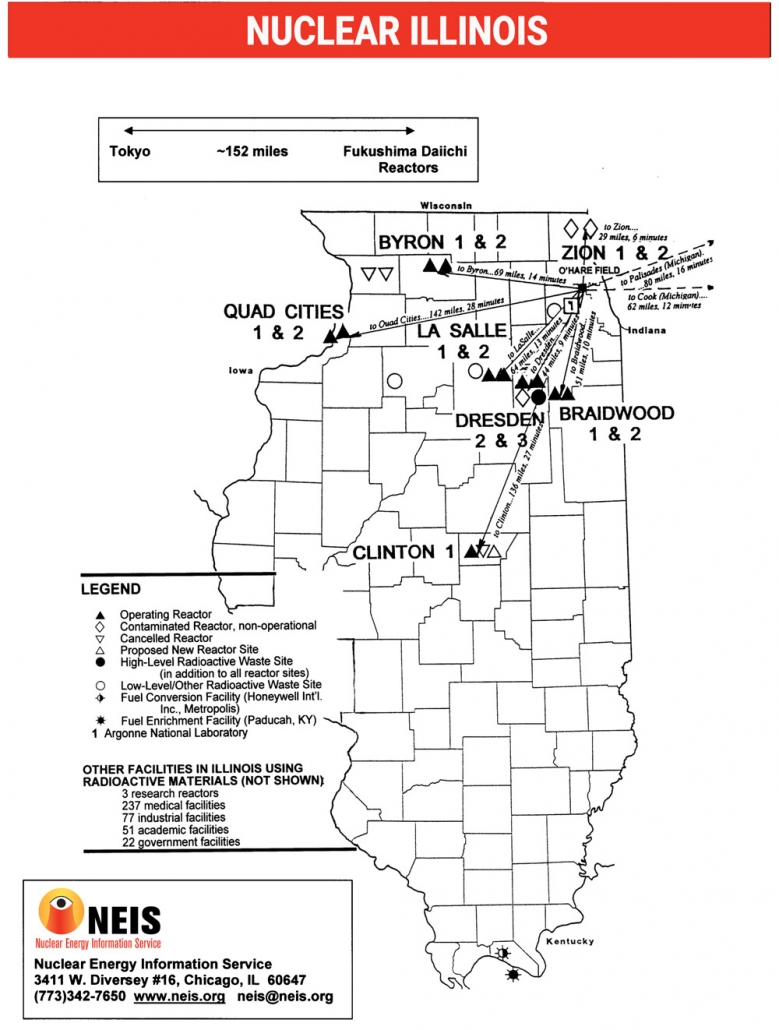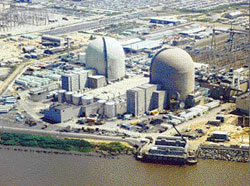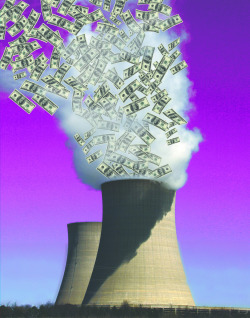Nuclear Costs
Estimates for new reactor construction costs continue to sky-rocket. Conservative estimates range between $6 and $12 billion per reactor but Standard & Poor's predicts a continued rise. The nuclear power industry is lobbying for heavy federal subsidization including unlimited loan guarantees but the Congressional Budget Office predicts the risk of default will be well over 50 percent, leaving taxpayers to foot the bill. Beyond Nuclear opposes taxpayer and ratepayer subsidies for the nuclear energy industry.
.................................................................................................................................................................................................................
Entries by admin (618)
ACTION ALERT -- Last Chance to take action on Illinois Energy Legislation!
 ACTION ALERT -- Last Chance to take action on Illinois Energy Legislation!
ACTION ALERT -- Last Chance to take action on Illinois Energy Legislation!
|
Dear Beyond Nuclear Members/Supporters in Illinois,
Please see the likley final, urgent action alert from Nuclear Energy Information Service (NEIS) of Chicago on this matter, below. If you've already taken action, thank you! Perhaps take action one more time again. If you haven't, please do so now. Please spread the word. Thank you!
---Kevin Kamps, Radioactive Waste Specialist, Beyond Nuclear
NEIS ACTION ALERT!
Illinois’ Energy Legislation Due for Completion This Week Your LAST Chance to Tell Them What You Want!
7 competing bills; over 3,500 pages of competing legislation!
Greetings All –
This week negotiations are expected to conclude on final text for an energy bill. This is your last opportunity to tell your officials what you want in it.
In addition NEIS is holding a special Night with the Experts segment on Thursday evening to discuss the nuclear-related elements that are NOT being considered in legislation that will have significant impacts on Illinois energy future. When the inevitable problems become crises, the Legislature will be expected once again to bailout Exelon. Join us for this discussion.
1.) CONTACT THE GOVERNOR AND YOUR ELECTED OFFICIALS:
We have long understood that the Illinois energy legislation that will be acted upon in 2021 will be an amalgam of pieces from the numerous proposed bills. Currently these bills cumulatively amount to between 3,000-4,000 pages of text. Except for discussion about bailouts, nuclear power is again excluded from detailed examination, significant nuclear-related issues have been ignored, and nuclear critics have been left out of direct discussions.
There are however items that must be included at all costs to end the continuous cycle of nuclear bailouts, subsidies, and threat of energy plant closures, all while trying to build an environmentally just and equitable 100% renewable energy system by 2050. Essential inclusions: Tell your State Senator and Representative that the final legislation MUST include these:
1.) No bailouts for Exelon’s unprofitable nuclear plants: You can’t build an energy future by bailout out the past. These reactors are solely the assets of a profitable private corporation – Exelon. It is their responsibility, and that of their Board, to find ways to run their assets profitably. Illinois ratepayers should not be viewed as an ATM machine for their corporate choices and failures. Nuclear bailouts have been shown to actually impede implementation of renewable energy. It’s the communities and workers affected by plant closures who will need the bailout, not profitable Exelon.
2.) Significant equity clauses and “just-transitions” packages for nuclear, coal, and other fossil fuel generator and mining communities faced with severe economic disruption as a result of their inevitable closures. Ideally, these programs should be initiated prior to facility closure when possible, and the funds escrowed to be available to the communities and workers to protect their tax base and create replacement economic opportunities when the facilities finally cease operations.
3.) Maximal financial support for an aggressive build-out of renewable energy, energy efficiency, energy storage, and improved electric transmission. If you want a 100% renewable energy future, then build one. Get to the State’s goal of 100% renewables by 2050 directly. Don’t waste more of OUR time and OUR money on soon to be extinct fossil fuels and nuclear power plants. To insure energy equity, make sure these buildouts are given priority to communities already economically disadvantaged or damaged from dirty fossil fuels and nuclear power. In this upcoming negotiation, nobody is going to get everything they want. But it’s high time that WE finally get what we’ve been demanding for decades – a clean and equitable energy future! Now!
WHAT YOU MUST DO:
Contact your State Senator and Representative, and the Governor and tell him/her that you want these three demands included in the final energy legislation, due to be completed by Friday, May 14.
Go here to find out who your elected officials are and get their contact information. Follow the instructions found there:
How to find your elected official
Here is the page you can go to to leave a direct message for the Governor: https://www2.illinois.gov/sites/gov/contactus/Pages/VoiceAnOpinion.aspx
2.) NIGHT WITH THE EXPERTS, Thursday, May 20th, 7 p.m. Central TZ, on ZOOM.
We’re a little early this month so that we can discuss topics that are NOT going into the massive energy legislation expected to be passed by the close of the Spring Legislative Session on May 31. NWTE is open to the public. Bring guests and friends! And in the meantime – take action for a clean-energy future!
3.) Can Illinois get to 100% Renewable Energy Future without Nuclear Power? With the legislative debate winding down on creating an Illinois energy future, we've heard the question come up often, from legislators in hearings, to reporters, to regular folks:
Can Illinois Get to "Carbon-Free/Nuclear-Free" Energy?
Well, do you really want to find out? or are you just posturing and being rhetorical?
If you genuinely want an answer, then please watch the most recent installment of NEIS' "Night with the Experts" with Dr. Mark Jacobson of Stanford University, who takes on this question head on:
Dr. Mark Z Jacobson Discussing “100 per cent Renewables is Possible” Thursday, April 29, 2021
Full version (with questions and discussion: TRT: 1:27:43 )
Jacobson presentation only: (TRT: 49:28)
Thanks in advance. We’ve done all we could. Your energy future is now in YOUR hands.
Be well, do great things,
--Dave Kraft, Director, NEIS--
 admin
admin
Multiple Charities Supported By ComEd Lobbied For Bills Favorable To The Utility Giant,
 admin
admin
Corruption not enough to embarrass utility giant from returning to Springfield with its hand out. Say no.
Biden's Bailout?! DE's Old Reactor Risks
 NRC file photo of Salem Units 1 and 2 in southern NJ, 18 miles from Wilmington, DEPresident Biden reportedly supports $195 billion in subsidies for 93 dangerously age-degraded atomic reactors across the U.S., as supposed climate emergency mitigation. Ironically, Biden's long-time political power base, Wilmington, DE, is very much in harm's way if a breakdown phase disaster occurs 18 miles away, at the three-reactor Salem/Hope Creek nuclear plant in southern NJ. According to NRC's 1982 CRAC-II report, if "just" the 45-year old Salem 1 reactor melted down, 100,000 "peak early fatalities" (acute radiation poisoning deaths) could occur, the worst figure for any U.S. reactor. 70,000 radiation injuries, 40,000 latent cancer fatalities, and 367 billion Year 2020 dollars in property damage could also result. Urge Biden to change course!
NRC file photo of Salem Units 1 and 2 in southern NJ, 18 miles from Wilmington, DEPresident Biden reportedly supports $195 billion in subsidies for 93 dangerously age-degraded atomic reactors across the U.S., as supposed climate emergency mitigation. Ironically, Biden's long-time political power base, Wilmington, DE, is very much in harm's way if a breakdown phase disaster occurs 18 miles away, at the three-reactor Salem/Hope Creek nuclear plant in southern NJ. According to NRC's 1982 CRAC-II report, if "just" the 45-year old Salem 1 reactor melted down, 100,000 "peak early fatalities" (acute radiation poisoning deaths) could occur, the worst figure for any U.S. reactor. 70,000 radiation injuries, 40,000 latent cancer fatalities, and 367 billion Year 2020 dollars in property damage could also result. Urge Biden to change course!
If Salem Unit 2 also melted down, casualties and property damages would double. (Hope Creek began operations in 1986; no figures for Hope Creek were included in the 1982 CRAC-II report, but a third meltdown at the site could reasonably be assumed to triple the casualties and property damages described above.)
Fukushima Daiichi in Japan did suffer a triple meltdown beginning on March 11, 2011.
CRAC-II refers to both a computer code (titled Calculation of Reactor Accident Consequences) and the 1982 report of the simulation results performed by Sandia National Laboratories for the Nuclear Regulatory Commission. The report is sometimes referred to as the CRAC-II report because it is the computer program used in the calculations, but the report is also known as the 1982 Sandia Siting Study or as NUREG/CR-2239.
In his June 2011 four-part series "Aging Nukes," Associated Press investigative journalist Jeff Donn reported that populations have soared around nuclear power plants like Salem/Hope Creek, meaning casualties would be even worse in 2021 than in 1982.
And although CRAC-II's property damage figures can be inflation-adjusted, from 1982 dollar figures to present day dollar figures, what is still not accounted for is economic development since 1982, that accompanied the population growth mentioned above.
As shocking as these reactor catastrophe casualty and property damage figures are, they would be dwarfed by a indoor wet storage pool for irradiated nuclear fuel fire. See, for example, the study by Von Hippel et al. This would also be true at the Salem/Hope Creek nuclear power plant, so dangerously close to Wilmington, DE.
BIDEN BAILOUT?! $195 Billion for Old Nukes?!
 "Burning Money" graphic by Gene Case/Avenging Angels.Friends of the Earth (FOE) warns the Biden administration's support for Production Tax Credits for 93 still operating, dangerously age-degraded atomic reactors across the U.S., could cost the American public $195 billion over the next decade. FOE's Program Manager Lukas Ross stated: "A nuclear bailout is wrong for taxpayers, wrong for ratepayers, and wrong for the climate. Paying to keep aging reactors online is courting disaster and guaranteed to slow the deployment of truly clean renewables. Congress and President Biden should not throw good money after bad." This bailout would be on top of many hundreds of billions of dollars in public subsidies lavished on the nuclear power industry over past decades. Urge President Biden to change course!
"Burning Money" graphic by Gene Case/Avenging Angels.Friends of the Earth (FOE) warns the Biden administration's support for Production Tax Credits for 93 still operating, dangerously age-degraded atomic reactors across the U.S., could cost the American public $195 billion over the next decade. FOE's Program Manager Lukas Ross stated: "A nuclear bailout is wrong for taxpayers, wrong for ratepayers, and wrong for the climate. Paying to keep aging reactors online is courting disaster and guaranteed to slow the deployment of truly clean renewables. Congress and President Biden should not throw good money after bad." This bailout would be on top of many hundreds of billions of dollars in public subsidies lavished on the nuclear power industry over past decades. Urge President Biden to change course!Biden backs $195 billion nuke bailout
Production tax credit for existing reactors would hurt electricity consumers and slow renewables




